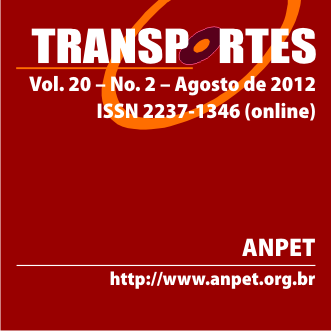Modelos de previsão de acidentes de trânsito em interseções semaforizadas de Fortaleza
DOI:
https://doi.org/10.4237/transportes.v20i2.558Abstract
As interseções viárias urbanas concentram grande parte dos acidentes de trânsito em virtude do elevado grau de interação entre usuários, veículos e via. Os modelos de previsão de acidentes são modelos de regressão que relacionam a frequência dos acidentes de trânsito com atributos geométricos e operacionais da via e lidam, com relativo sucesso, com o elevado grau de aleatoriedade desse fenômeno. O objetivo deste trabalho é desenvolver modelos de previsão de acidentes de trânsito para interseções semaforizadas da cidade de Fortaleza, com ênfase na metodologia para a construção de modelos simples e confiáveis. Os modelos foram estimados com uma amostra de 101 interseções em função do volume médio diário anual, número de faixas, número de aproximações e tipo de separador central. O modelo contendo o fluxo e número de faixas apresentou desempenho satisfatório para a predição do número total de acidentes de trânsito nas interseções semaforizadas avaliadas.
Palavras-chave: modelos de previsão de acidentes, acidentes de trânsito, modelos lineares generalizados, modelagem de segurança viária.
Abstract: Urban road intersections concentrate a significant portion of traffic accidents due to the high degree of interaction between users, vehicles and route. Accident prediction models are regression models that establish a relationship between the frequency of traffic accidents and geometric and operational attributes of the road, dealing, with relative success, with the high degree of randomness of this phenomenon. The objective of this work is to develop traffic accident prediction models for signalized intersections located in the city of Fortaleza, with emphasis on the methodology for the development of simple and reliable models. The models were estimated based on a sample of 101 intersections, having as prediction variables annual average daily traffic (AADT), number of lanes, number of approaches, and type of central median. The model containing AADT and number of lanes showed satisfactory performance for the estimation of the total number of traffic accidents at the evaluated intersections.
Keywords: safety prediction models, safety performance functions, generalized linear models, road safety modeling.
Downloads
Downloads
Published
How to Cite
Issue
Section
License
Authors who submit papers for publication by TRANSPORTES agree to the following terms:
- The authors retain the copyright and grant Transportes the right of first publication of the manuscript, without any financial charge, and waive any other remuneration for its publication by ANPET.
- Upon publication by Transportes, the manuscript is automatically licensed under the Creative Commons License CC BY 4.0 license. This license permits the work to be shared with proper attribution to the authors and its original publication in this journal.
- Authors are authorized to enter into additional separate contracts for the non-exclusive distribution of the version of the manuscript published in this journal (e.g., publishing in an institutional repository or as a book chapter), with recognition of the initial publication in this journal, provided that such a contract does not imply an endorsement of the content of the manuscript or the new medium by ANPET.
- Authors are permitted and encouraged to publish and distribute their work online (e.g., in institutional repositories or on their personal websites) after the editorial process is complete. As Transportes provides open access to all published issues, authors are encouraged to use links to the DOI of their article in these cases.
- Authors guarantee that they have obtained the necessary authorization from their employers for the transfer of rights under this agreement, if these employers hold any copyright over the manuscript. Additionally, authors assume all responsibility for any copyright infringements by these employers, releasing ANPET and Transportes from any responsibility in this regard.
- Authors assume full responsibility for the content of the manuscript, including the necessary and appropriate authorizations for the disclosure of collected data and obtained results, releasing ANPET and Transportes from any responsibility in this regard.









